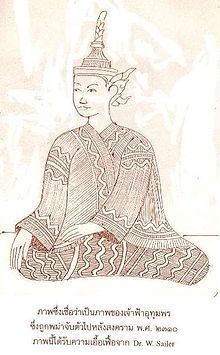Reign Two months in 1758 Parents Borommakot | Mother Princess Phiphitmontri Grandparent Suriyenthrathibodi | |
 | ||
Similar Ekkathat, Suriyenthrathibodi, Uthong, Narai, Suriyothai | ||
Uthumphon (Thai: อุทุมพร; Burmese: ဥဒုမ္ဗရ) or Uthumphon Mahaphon Phinit (Thai: อุทุมพรมหาพรพินิต) was the 32nd and penultimate monarch of the Ayutthaya Kingdom, ruling in 1758 for about two months. Facing various throne claimants, Uthumphon was finally forced to abdicate and enter monkhood. His preference of being a monk rather than keep the throne, earned him the epithet "Khun Luang Ha Wat" (Thai: ขุนหลวงหาวัด), or "the king who prefers the temple".
Contents
Reign and Abdication
Prince Dok Duea or Prince Uthumphon — "Dok Duea" (ดอกเดื่อ) and "Uthumphon" (อุทุมพร), both meaning udumbhara or "fig", was a son of Borommakot. In 1746, his elder brother, Prince Thammathibet who had been appointed as the Front Palace, was beaten to death for his affair with one of Borommakot's concubines. Borommakot didn't appoint the new Front Palace as Kromma Khun Anurak Montri or Ekkathat, the next in succession line, was proved to be incompetent. In 1757, Borommakot finally decided to skip Anurak Montri altogether and made Uthumphon the Front Palace—becoming Kromma Khun Phon Phinit.
In 1758, upon the passing of Borommakot, Uthumphon was crowned. However, he faced oppositions from his three half-brothers, namely, Kromma Muen Chit Sunthon, Kromma Muen Sunthon Thep, and Kromma Muen Sep Phakdi. Uthumphon had his half-brothers arrested and executed.
Ekkathat, forced to become a monk, decided to leave the priesthood and seek the throne. Uthumporn then gave up his throne to his brother and entered a monastery as a monk.
Burmese Invasions
In 1760, Alaungpaya of Burma led his armies invading Ayutthaya. Uthumphon was asked to leave the monastery to fight against the Burmese. However, Alaungpaya was wounded during the siege, and died during the subsequent Burmese retreat.
Uthumphon, once again, returned to the Pradu Rongtham monastery.
The Burmese, however, came back in 1767 under the commission of Hsinbyushin and led by Ne Myo Thihapate. Ayutthaya under Ekkathat was in turmoil, without authorities or powers to counter the Burmese invaders.
Though he was strongly urged to take role in leading Siamese armies, Uthumphon chose to stay in the monk status. Ayutthaya finally fell. Uthumphon was captured by the Burmese forces and was brought to Burma along with a large number of Ayutthaya's people.
Later life
Uthumphon was grounded near Ava, along with other Ayutthaya ex-nobles, where he was forced by the Burmese to give them knowledge about the history and court customs of Ayutthaya—preserved in the Ayutthayan affidavit, or The Testimony of Khun Luang Ha-wat.
Hsinbyushin built a village near Mandalay for Uthumphon and his Siamese people—who then became the Yodia people. In accordance with Burmese chronicles, Uthumphon, as a monk, died in 1796 in the village. He was believed to be entombed in a chedi at the Linzin Hill graveyard on the edge of Taungthaman Lake in Mandalay Region's Amarapura Township.
Legacy
On 29 June 2013, Burmese and Thai authorities announced that the site of Utumphon's memorial tomb would be renovated and turned into a historical park. Since February 2013, a joint Burmese-Thai excavation team of archaeologists, uncovered bones and fragments of a monk's robes in a gilt glass mosaic alms bowl containing bones and robes. The Thai restoration team is expected to spend US$3.23 million on the project. In late 2013, archaeologists uncovered a brick structure believed to be a monastery that once held stone inscriptions. The team has laid out plans for a 3.95 acres (1.60 ha) memorial ground and is seeking the permission of local authorities to establish a cultural heritage centre there, including restoration of the royal graveyard complex, at a cost of at least 39 million baht (US$1.23 million).
